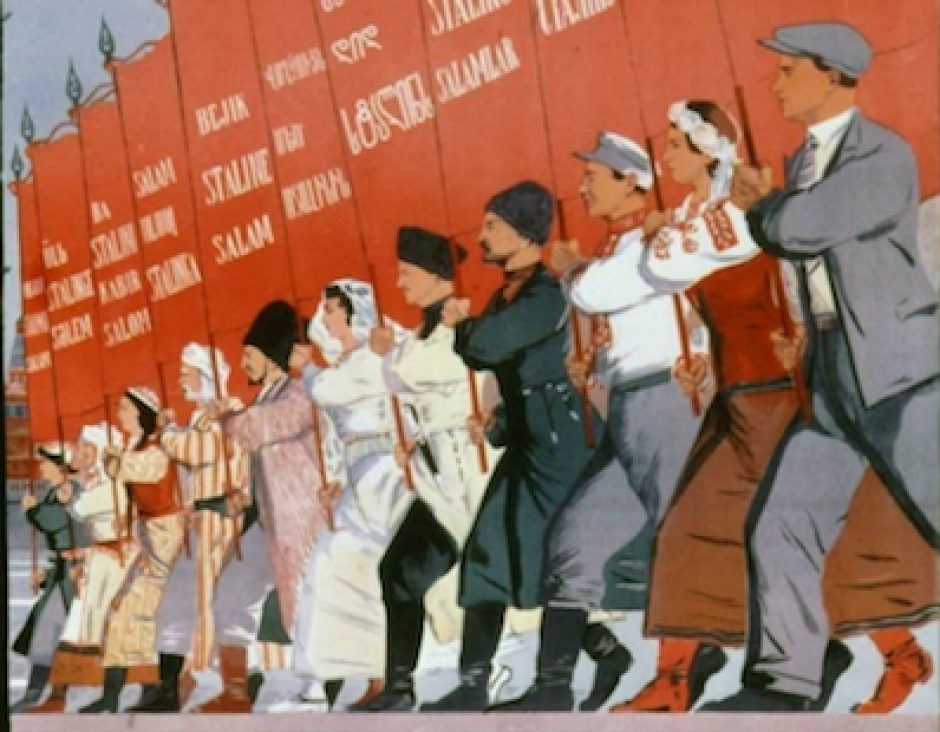“Realistic in Form, Socialist in Content”
Socialist realism was the official style of art in the Soviet Union from 1932 to 1988. It is characterized by a realistic painting style depicting Soviet values, particularly through images of daily life.

Stalin and Voroshilov in the Kremlin by Aleksandr Gerasimov
Though the term “socialist realism” was not introduced until the 1930s, the realist style of painting existed much earlier. Although his work did not include the same socialist content, Ilya Repin is an example of early realism in Russian art.

Ivan the Terrible and his son Ivan by Ilya Repin
The prevalent artistic movement in Russia before socialist realism was Russian avant-garde. Notable artists of this movement include Kazimir Malevich, Wassily Kandinsky, and Vladimir Tatlin.

Composition VIII by Wassily Kandinsky

Black Square by Kazimir Malevich
The style reached its peak in terms of creativity and popular consumption between 1917 and 1932. This movement included styles like Neo-primitivism, Constructivism, Suprematism, and Futurism. Though some Russian avant-garde paintings expressed Soviet values, the style was very different from that which the party would eventually support. There were initially two groups of Soviet art, traditionalism and futurism. An example of futurist painting can be seen below in Natalia Goncharova’s painting, Cyclist. Supporters of futurism argued that it was the more revolutionary of the two styles. However, support for this style ended in the early 30s and the traditionalist socialist realism style became the official style of art in the Soviet Union (Osipova, 2017).

Cyclist by Natalia Goncharova
The style of Soviet Realism was formalized at the All-Union Writers Congress in August of 1934. The works of this style were supposed to be relatable to the workers, present a realistic depiction of daily life, and support the aims and values of the state. They presented reality as it was and the future of the Soviet narrative – the future the people we’re struggling for. The painting and sculpture typically depicted romanticized images of urban workers and farm laborers, industry and technology, and party leaders, often Lenin or Stalin (Bown, Elliott, and Museum of Modern Art 1992).

Letter from the Front by Aleksandr Laktionov

The Unification of Ukrainian Lands by Mikhail Khmelko

Collective Farm Celebration by Arkady Plastov
As we can see in the above paintings, the realistic style and bright color scheme give the paintings a sense of hope or happiness, while capturing daily life and expressing party values (Rusnock 2010). Plastov’s Collective Farm Celebration shows a bright day, and abundance of food, and a large group of people, all sharing in the bounty of their labor. Khmelko’s painting depicts a success of the Soviet policy of national self-determination. A large group of Ukrainians shown in their traditional clothing shake hands with and applaud Soviet officials, embracing both their national identity and their part in the Soviet state.
Worker and Kolkhoz Woman by Vera Mukhina
Worker and Farm Woman – statue originally in Vilnius, Lithuania
The art of Socialist Realism often glorified the workers, both urban factory workers and farm laborers. This can be seen in the above statue, originally in Vilnius, Lithuania, and one of the most iconic piece of Soviet sculpture, Vera Mukhina’s Worker and Kolkhoz Woman. Mukhina’s statue would become the logo for the Soviet film studio Mosfilm. The painting and sculpture of socialist realism also commonly featured Soviet and communist leaders. Most commonly depicted were Lenin, Stalin, or Marx.

Lenin in Smolny by Isaak Brodsky

Lenin on the Tribune by Aleksandr Gerasimov

Leader, Teacher, and Friend by Grigory Shegal
Works Cited
Bown, Matthew Cullerne, David Elliott, and Museum of Modern Art, eds. 1992. Soviet Socialist Realist Painting: 1930s – 1960s ; Paintings from Russia, the Ukraine, Belorussia, Uzbekistan, Kirgizia, Georgia, Armenia, Azerbaijan and Moldova, Selected in the USSR by Matthew Cullerne Bown [Exhibition January 12 – March 15 1992, Oxford]. Oxford: Museum of Modern Art.
Osipova, Irina. 2017. “How the Russian Avant-Garde Came to Serve the Revolution.” Russia Beyond. June 23, 2017. https://www.rbth.com/arts/2017/06/23/how-the-russian-avant-garde-came-to-serve-the-revolution_788467.
Rusnock, K. Andrea. 2010. Socialist Realist Painting during the Stalinist Era (1934-1941): The High Art of Mass Art. Lewiston, N.Y: Edwin Mellen Press.


